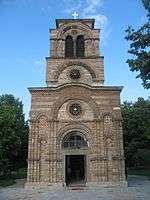Varnava, Serbian Patriarch
| Serbian Patriarch Varnava I Српски патријарх Варнава I | |
|---|---|
| His Holiness the Archbishop of Peć, Metropolitan of Belgrade and Karlovci, and Serbian Patriarch | |
 | |
| Church | Serbian Orthodox Church |
| See | Belgrade |
| Installed | May 12, 1930 |
| Term ended | July 23, 1937 |
| Predecessor | Dimitrije I |
| Successor | Gavrilo V |
| Orders | |
| Ordination | 1905 |
| Consecration | 1910 |
| Personal details | |
| Birth name | Petar Rosić |
| Born |
September 11, 1880 Pljevlja, Ottoman Empire |
| Died |
July 23, 1937 (aged 56) Belgrade, Yugoslavia |
| Styles of Serbian Patriarch Varnava I | |
|---|---|
| Reference style | His Holiness |
| Spoken style | Your Holiness |
| Religious style | Patriarch |
| Posthumous style | His Holiness Patriarch Varnava I of Blessed Repose |
Varnava Rosić (Serbian Cyrillic: Варнава Росић) was the Patriarch of the Serbian Orthodox Church between 1930 and 1937.[1] He was born Petar Rosić in Pljevlja, belonging at that time to the Ottoman Empire, on August 29, 1880.
Since Metropolitan Parthenios of Debar and Veles (1907-1913) was frequently absent from his eparchy serving as a member of Holy Synod in Constantinople, it was decided that an auxiliary bishop should be appointed for administration of the eparchy. By that time, Varnava Rosić was serving as a Serbian Orthodox priest in Constantinople and he was chosen and consecrated as bishop on 10th of April 1910 in the Patriarchal Church of Saint George. As an auxiliary bishop serving in the Eparchy of Debar and Veles, he welcomed the liberation of that region from Turkish rule in 1912 and annexation to the Kingdom of Serbia. Metropolitan Parthenios was finally transferred to another eparchy in 1913, and bishop Varnava was left in charge not only in the Eparchy of Debar and Veles, since administration of other ecclesiastical territories annexed to Kingdom of Serbia was also entrusted to him.
During First World War, upon the Bulgarian occupation of southern parts of Kingdom of Serbia in 1915, he had to leave his eparchy, returning after liberation in 1918. In 1920, he was elected Metropolitan of Skopje, and served in that eparchy until 1930, when he became new Serbian Patriarch.
During the office of Varnava, the dioceses of Zagreb and Mukacheve were formed. Between 1931 and 1937, the Serbian Church consisted of 27 dioceses and a vicarate in Skadar, Albania. Church life was on the move in all regions. Many monasteries, churches and church buildings were erected, some of these being the present Patriarchate building in Belgrade, Vavedenje Monastery, etc. The construction of the edifice of the great Temple of Saint Sava was initiated in Belgrade (one of the largest churches in the world).
Varnava firmly resisted the introduction of legislation giving greater privileges to the Roman Catholic Church not in Yugoslavia in general, but in Serbia in particular (hence The Concordat Crisis). He maintained that these would certainly undermine positions of both the Serbian Orthodox church and those of other faiths in the country. He died unexpectedly during the night between July 23–24, 1937 when the Concordat legislation was carried into Parliament. The Holy Synod was also against government pro-Concordat policy, and the government was soon forced to withdraw this new legislation.
Many people believed that Patriarch Varnava was poisoned because of his struggle against Concordat, and his death is still unresolved.
He was the great-uncle of performance artist Marina Abramović.
References
- ↑ Serbian Orthodox Church, history at spc.rs
Sources
- Др. Ђоко Слијепчевић (2008). "Конкордат и смрт патријарха Варнаве". Rastko.
| Eastern Orthodox Church titles | ||
|---|---|---|
| Preceded by Dimitrije I |
Serbian Patriarch 1930–1937 |
Succeeded by Gavrilo V |
| Wikimedia Commons has media related to Patriarch Varnava of Serbia. |
